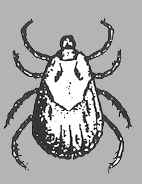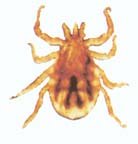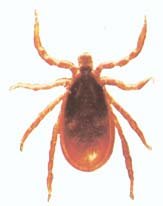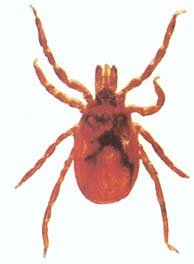
GRAPE VINE
Tick Transrnitted Diseases in Indiana
Timothy J. Gibb Entomology Diagnostician
Spring and fall represent the two seasons when complaints of ticks are most common.
Ticks are always a nuisance pest but can also be a serious health threat if they transmit
diseases. Recent findings by the "Rocky Mountain Spotted Fever and Lyme Disease
Surveillance Program" in Indiana, located at Ball State University indicate that
although these two diseases can be transmitted by ticks in our state, the frequency of
actual disease transmission remains fairly low. In fact, only two cases of Rocky Mountain
Spotted Fever and 24 cases of Lyme Disease were confirmed in the state during 1998.
Based on historical data, predictions are that the cases of Rocky Mountain Spotted fever will remain low. In contrast, however, we may see an increase in the incidence of Lyme disease. This is because the spread of these diseases is a function of the species or the kind of tick that transmits them. There are several species of ticks that occur in Indiana but the most frequently reported ticks are the blacklegged tick (Ixodes scapularis), American dog tick (Dermacentor variabilis) and the Lone Star tick(Ambylyomma americanum).
Whether or not you become a victim of either of Rocky Mountain Spotted Fever, or lyme disease is a function of which tick it is that bites you. For example, the blacklegged tick and the Lone Star tick may carry the disease agent which causes Lyme disease, whereas the American Dog tick is the primary vector of Rocky Mountain Spotted Fever.
General appearance of unted hard ticks as exhibited by Ixodes scaplularis, black-legged tick.
(Tick markings and color may vary.)
|

|

|
 |
Larva |
Nymph |
Adult male |
Adult female |
The reason that the predicted disease incidence rates may differ is because the distribution of the American Dog Tick seems to remain relatively constant from year to year. However, the distribution of the Lone Star Tick and the blacklegged tick is expanding in response to the availability of suitable hosts, primarily deer. Thus, expanding populations could also result in an increase in the number of cases of Lyme disease reported in our state.
The seasonal distribution of the ticks reported are also closely related to the species of ticks found. For example, the majority of the springtime ticks are American dog ticks, whereas the majority of ticks during the fall are blacklegged ticks. If you are interested in having a particular tick identified or tested for diseases, you may call Dr. Bob Pinger in the Department of Physiology and Health Science at Ball State University at 765-285-1504. http://www.bsu.edu/csh/phs/phel.html The tick will need to be submitted alive and in good condition in order to perform the test.